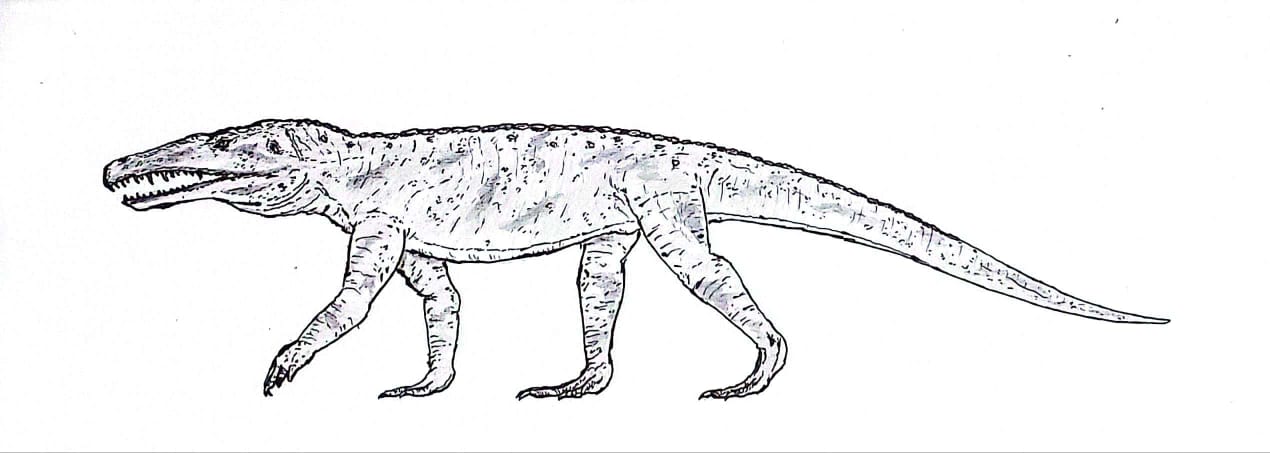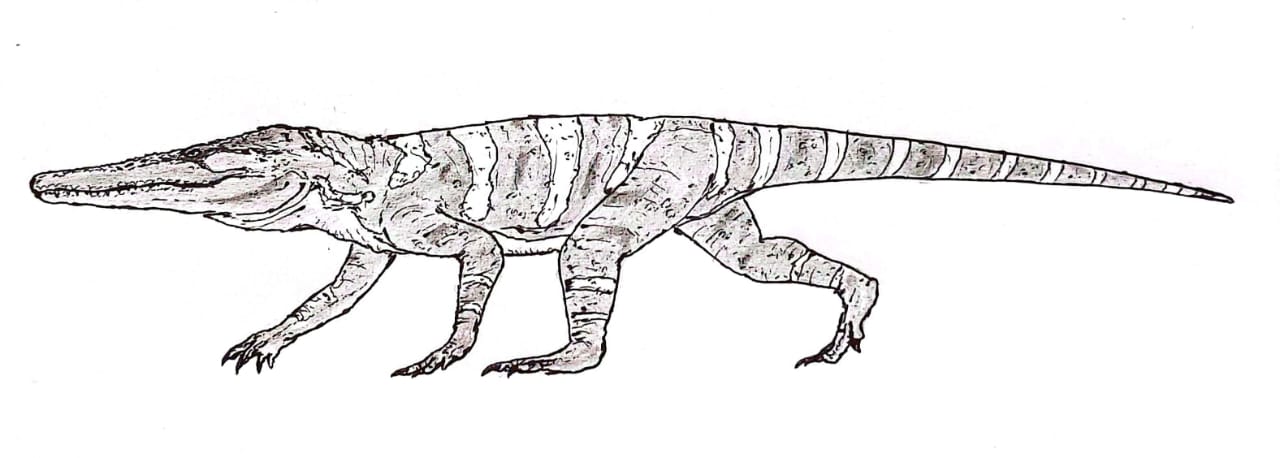|
Tropidosuchus
''Tropidosuchus'' is an extinct genus of carnivorous archosauriforms from the Middle Triassic period (Anisian to Ladinian stage). It is a proterochampsid which lived in what is now Argentina. It is known from the holotype PVL 4601, which consists of partial skeleton. It was found in the Chañares Formation and its type locality is the Chañares River. It was first named by A. B. Arcucci in 1990 and the type species In International_Code_of_Zoological_Nomenclature, zoological nomenclature, a type species (''species typica'') is the species name with which the name of a genus or subgenus is considered to be permanently taxonomically associated, i.e., the spe ... is ''Tropidosuchus romeri''. References Proterochampsia Ladinian genera Middle Triassic reptiles of South America Triassic Argentina Fossils of Argentina Chañares Formation Fossil taxa described in 1990 Prehistoric reptile genera {{triassic-reptile-stub ... [...More Info...] [...Related Items...] OR: [Wikipedia] [Google] [Baidu] |
Proterochampsidae
Proterochampsidae is a family of proterochampsian archosauriforms. Proterochampsids may have filled an ecological niche similar to modern crocodiles, and had a general crocodile-like appearance. They lived in what is now South America in the Middle and Late Triassic. Description Proterochampsids have long, crocodile-like skulls. The posterior portion of the skull is wide while the snout is very narrow. Most proterochampsids also have downturned snouts. Like many early archosauriforms, they also have dermal armour. Proterochampsids have small holes called dorsal fenestrae at the top of their skulls. Unlike other early archosauromorphs, they do not have a parietal foramin, which in many reptiles holds a parietal eye. The postorbital bones behind the eye sockets have thick, jagged crests. As another diagnostic feature of the group, the holes that allow the passage of the internal carotid artery through the braincase open at the sides of a bony projection called the basipterygoid ... [...More Info...] [...Related Items...] OR: [Wikipedia] [Google] [Baidu] |
Chañares Formation
The Chañares Formation is a Carnian-age geologic formation of the Ischigualasto-Villa Unión Basin, located in La Rioja Province, Argentina. It is characterized by drab-colored fine-grained volcaniclastic claystones, siltstones, and sandstones which were deposited in a fluvial to lacustrine environment. The formation is most prominently exposed within Talampaya National Park, a UNESCO World Heritage Site within La Rioja Province. The Chañares formation is the lowermost stratigraphic unit of the Agua de la Peña Group, overlying the Tarjados Formation of the Paganzo Group, and underlying the Los Rastros Formation. Though previously considered Ladinian in age, U-Pb dating has determined that most or all of the Chañares Formation dates to the early Carnian stage of the Late Triassic.Kent et al, 2014, p.7959 The Chañares Formation has provided a diverse and well-preserved faunal assemblage which has been studied intensively since the 1960s. The most common reptiles were ... [...More Info...] [...Related Items...] OR: [Wikipedia] [Google] [Baidu] |
Proterochampsia
Proterochampsia is a clade of early archosauriform reptiles from the Triassic period. It includes the Proterochampsidae (e.g. '' Proterochampsa'', '' Chanaresuchus'' and '' Tropidosuchus'') and probably also the Doswelliidae. Nesbitt (2011) defines Proterochampsia as a stem-based taxon that includes '' Proterochampsa barrionuevoi'' and all forms more closely related to it than '' Euparkeria capensis'', ''Erythrosuchus africanus'', '' Passer domesticus'' (the House Sparrow), or ''Crocodylus niloticus'' (the Nile crocodile). Therefore, the inclusion of Doswelliidae in it is dependent upon whether '' Doswellia'' and '' Proterochampsa'' form a monophyletic group to the exclusion of Archosauria and other related groups. Description Nesbitt (2011) found that Proterochampsians share several distinguishing characteristics, or synapomorphies. A prominent ridge runs along the length of the jugal, a bone below the eye. Another ridge is present on the quadratojugal, a bone positioned t ... [...More Info...] [...Related Items...] OR: [Wikipedia] [Google] [Baidu] |
Archosauriform
Archosauriformes (Greek for 'ruling lizards', and Latin for 'form') is a clade of diapsid reptiles encompassing archosaurs and some of their close relatives. It was defined by Jacques Gauthier (1994) as the clade stemming from the last common ancestor of Proterosuchidae and Archosauria. Phil Senter (2005) defined it as the most exclusive clade containing '' Proterosuchus'' and Archosauria. Gauthier as part of the ''Phylonyms'' (2020) defined the clade as the last common ancestor of '' Gallus'', ''Alligator'', and '' Proterosuchus'', and all its descendants. Archosauriforms are a branch of archosauromorphs which originated in the Late Permian (roughly 252 million years ago) and persist to the present day as the two surviving archosaur groups: crocodilians and birds. Archosauriforms present several traits historically ascribed to the group Archosauria. These include serrated teeth set in deep sockets, a more active metabolism, and an antorbital fenestra (a hole in the skull in fro ... [...More Info...] [...Related Items...] OR: [Wikipedia] [Google] [Baidu] |
Middle Triassic
In the geologic timescale, the Middle Triassic is the second of three epoch (geology), epochs of the Triassic period (geology), period or the middle of three series (stratigraphy), series in which the Triassic system (stratigraphy), system is divided in chronostratigraphy. The Middle Triassic spans the time between annum, Ma and Ma (million years ago). It is preceded by the Early Triassic Epoch and followed by the Late Triassic Epoch. The Middle Triassic is divided into the Anisian and Ladinian age (geology), ages or stage (stratigraphy), stages. Formerly the middle series in the Triassic was also known as Muschelkalk. This name is now only used for a specific unit of stratum, rock strata with approximately Middle Triassic age, found in western Europe. Middle Triassic life Following the Permian–Triassic extinction event, the most devastating of all mass-extinctions, life recovered slowly. In the Middle Triassic, many groups of organisms reached higher diversity again, s ... [...More Info...] [...Related Items...] OR: [Wikipedia] [Google] [Baidu] |
Fossils Of Argentina
A fossil (from Classical Latin , ) is any preserved remains, impression, or trace of any once-living thing from a past geological age. Examples include bones, shells, exoskeletons, stone imprints of animals or microbes, objects preserved in amber, hair, petrified wood and DNA remnants. The totality of fossils is known as the ''fossil record''. Though the fossil record is incomplete, numerous studies have demonstrated that there is enough information available to give a good understanding of the pattern of diversification of life on Earth. In addition, the record can predict and fill gaps such as the discovery of ''Tiktaalik'' in the arctic of Canada. Paleontology includes the study of fossils: their age, method of formation, and evolutionary significance. Specimens are sometimes considered to be fossils if they are over 10,000 years old. The oldest fossils are around 3.48 billion years to 4.1 billion years old. Early edition, published online before print. The ob ... [...More Info...] [...Related Items...] OR: [Wikipedia] [Google] [Baidu] |
Triassic Argentina
The Triassic ( ; sometimes symbolized 🝈) is a geologic period and system which spans 50.5 million years from the end of the Permian Period 251.902 million years ago ( Mya), to the beginning of the Jurassic Period 201.4 Mya. The Triassic is the first and shortest period of the Mesozoic Era and the seventh period of the Phanerozoic Eon. Both the start and end of the period are marked by major extinction events. The Triassic Period is subdivided into three epochs: Early Triassic, Middle Triassic and Late Triassic. The Triassic began in the wake of the Permian–Triassic extinction event, which left the Earth's biosphere impoverished; it was well into the middle of the Triassic before life recovered its former diversity. Three categories of organisms can be distinguished in the Triassic record: survivors from the extinction event, new groups that flourished briefly, and other new groups that went on to dominate the Mesozoic Era. Reptiles, especially archosaurs, were the chief terr ... [...More Info...] [...Related Items...] OR: [Wikipedia] [Google] [Baidu] |
Middle Triassic Reptiles Of South America
Middle or The Middle may refer to: * Centre (geometry), the point equally distant from the outer limits. Places * Middle (sheading), a subdivision of the Isle of Man * Middle Bay (other) * Middle Brook (other) * Middle Creek (other) * Middle Island (other) * Middle Lake (other) * Middle Mountain, California * Middle Peninsula, Chesapeake Bay, Virginia * Middle Range, a former name of the Xueshan Range on Taiwan Island * Middle River (other) * Middle Rocks, two rocks at the eastern opening of the Straits of Singapore * Middle Sound, a bay in North Carolina * Middle Township (other) * Middle East Music * "Middle" (song), 2015 * "The Middle" (Jimmy Eat World song), 2001 * "The Middle" (Zedd, Maren Morris and Grey song), 2018 *"Middle", a song by Rocket from the Crypt from their 1995 album ''Scream, Dracula, Scream!'' *"The Middle", a song by Demi Lovato from their debut album ''Don't Forget'' *"The Middle", a song by Th ... [...More Info...] [...Related Items...] OR: [Wikipedia] [Google] [Baidu] |
Ladinian Genera
The Ladinian is a stage and age in the Middle Triassic series or epoch. It spans the time between Ma and ~237 Ma (million years ago). The Ladinian was preceded by the Anisian and succeeded by the Carnian (part of the Upper or Late Triassic). The Ladinian is coeval with the Falangian regional stage used in China. Stratigraphic definitions The Ladinian was established by Austrian geologist Alexander Bittner in 1892. Its name comes from the Ladin people that live in the Italian Alps (in the Dolomites, then part of Austria-Hungary). The base of the Ladinian Stage is defined as the place in the stratigraphic record where the ammonite species '' Eoprotrachyceras curionii'' first appears or the first appearance of the conodont '' Budurovignathus praehungaricus''. The global reference profile for the base (the GSSP) is at an outcrop in the river bed of the Caffaro river at Bagolino, in the province of Brescia, northern Italy.The GSSP was established by Brack ''et al.'' (2005) Th ... [...More Info...] [...Related Items...] OR: [Wikipedia] [Google] [Baidu] |
Type Species
In International_Code_of_Zoological_Nomenclature, zoological nomenclature, a type species (''species typica'') is the species name with which the name of a genus or subgenus is considered to be permanently taxonomically associated, i.e., the species that contains the biological Type (biology), type wiktionary:en:specimen, specimen (or specimens). Article 67.1 A similar concept is used for suprageneric groups and called a type genus. In botanical nomenclature, these terms have no formal standing under the International Code of Nomenclature for algae, fungi, and plants, code of nomenclature, but are sometimes borrowed from zoological nomenclature. In botany, the type of a genus name is a specimen (or, rarely, an illustration) which is also the type of a species name. The species name with that type can also be referred to as the type of the genus name. Names of genus and family ranks, the various subdivisions of those ranks, and some higher-rank names based on genus names, have suc ... [...More Info...] [...Related Items...] OR: [Wikipedia] [Google] [Baidu] |
Holotype
A holotype (Latin: ''holotypus'') is a single physical example (or illustration) of an organism used when the species (or lower-ranked taxon) was formally described. It is either the single such physical example (or illustration) or one of several examples, but explicitly designated as the holotype. Under the International Code of Zoological Nomenclature (ICZN), a holotype is one of several kinds of name-bearing types. In the International Code of Nomenclature for algae, fungi, and plants (ICN) and ICZN, the definitions of types are similar in intent but not identical in terminology or underlying concept. For example, the holotype for the butterfly '' Plebejus idas longinus'' is a preserved specimen of that subspecies, held by the Museum of Comparative Zoology at Harvard University. In botany and mycology, an isotype is a duplicate of the holotype, generally pieces from the same individual plant or samples from the same genetic individual. A holotype is not necessarily "ty ... [...More Info...] [...Related Items...] OR: [Wikipedia] [Google] [Baidu] |






